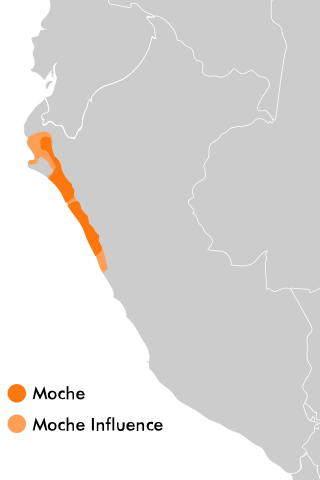Related Research Articles

Egyptology is the scientific study of ancient Egypt. The topics studied include ancient Egyptian history, language, literature, religion, architecture and art from the 5th millennium BC until the end of its native religious practices in the 4th century AD.
Pachacámac is an archaeological site 40 kilometres (25 mi) southeast of Lima, Peru in the Valley of the Lurín River. The site was first settled around A.D. 200 and was named after the "Earth Maker" creator god Pacha Kamaq. The site flourished for about 1,300 years until the Spanish invaded. Pachacamac covers about 600 hectares of land.

The archaeology of the Americas is the study of the archaeology of the Western Hemisphere, including North America (Mesoamerica), Central America, South America and the Caribbean. This includes the study of pre-historic/pre-Columbian and historic indigenous American peoples, as well as historical archaeology of more recent eras, including the trans-Atlantic slave trade and European colonization.

Saqqara, also spelled Sakkara or Saccara in English, is an Egyptian village in the markaz (county) of Badrashin in the Giza Governorate, that contains ancient burial grounds of Egyptian royalty, serving as the necropolis for the ancient Egyptian capital, Memphis. Saqqara contains numerous pyramids, including the Pyramid of Djoser, sometimes referred to as the Step Pyramid, and a number of mastaba tombs. Located some 30 km (19 mi) south of modern-day Cairo, Saqqara covers an area of around 7 by 1.5 km.

The Moche civilization flourished in northern Peru with its capital near present-day Moche, Trujillo, Peru from about 100 to 800 AD during the Regional Development Epoch. While this issue is the subject of some debate, many scholars contend that the Moche were not politically organized as a monolithic empire or state. Rather, they were likely a group of autonomous polities that shared a common culture, as seen in the rich iconography and monumental architecture that survives today.

The Sacred City of Caral-Supe, or simply Caral, is an archaeological site in Peru where the remains of the main city of the Caral civilization are found. It is located in the Supe valley of Peru, near the current town of Caral, 182 kilometers north of Lima, 23 km from the coast and 350 metres above sea level. It is attributed an antiquity of 5,000 years and it is considered the oldest city in the Americas and one of the oldest in the world. No other site has been found with such a diversity of monumental buildings or different ceremonial and administrative functions in the Americas as early as Caral. It has been declared a Humanity Cultural Heritage site by UNESCO.

Chimor was the political grouping of the Chimú culture. The culture arose about 900 CE, succeeding the Moche culture, and was later conquered by the Inca emperor Topa Inca Yupanqui around 1470, fifty years before the arrival of the Spanish in the region. Chimor was the largest kingdom in the Late Intermediate Period, encompassing 1,000 kilometres (620 mi) of coastline.
Below are notable events in archaeology that occurred in 1948.

The practice of human sacrifice in pre-Colombian cultures, in particular Mesoamerican and South American cultures, is well documented both in the archaeological records and in written sources. The exact ideologies behind child sacrifice in different pre-Colombian cultures are unknown but it is often thought to have been performed to placate certain gods.

Paititi is a legendary Inca lost city or utopian rich land. It allegedly lies east of the Andes, hidden somewhere within the remote rainforests of southeast Peru, northern Bolivia or northwest Brazil. The Paititi legend in Peru revolves around the story of the culture-hero Inkarri, who, after he had founded Q'ero and Cusco, retreated toward the jungles of Pantiacolla to live out the rest of his days in his refuge city of Paititi. Other versions of the legend see Paititi as an Inca refuge in the border area between Bolivia and Brazil.
A previously unknown Inca settlement, Quriwayrachina, Quri Wayrachina, or Qoriwayrachina, was found in the Willkapampa mountain range in the Cusco Region of Peru in 2001. The site lies in the Santa Teresa District of the La Convención Province, north of the archaeological site of Choquequirao and west of the mountains Kiswar and Quriwayrachina (Corihuayrachina), on a mountain named Victoria. Close to nearby ancient Inca mines, the surrounding hills are covered with the littered stones from more than 200 structures in this Inca outpost.
This page lists major events of 2009 in archaeology.

The Lady of Cao is a name given to a female Moche mummy discovered at the archeological site El Brujo, which is located about 45 km north of Trujillo in the La Libertad Region of Peru.

Thierry Jamin is a French explorer and pseudohistorian known for his research about Paititi and the presence of the Incas and pre-Inca civilization in the Amazonian rainforest.
The year 2014 in archaeology involved some significant events.
The Chotuna Chornancap Archaeological Complex is an archaeological site in San Jose district, Lambayeque Region, 12 kilometres (7.5 mi) north-west of Chiclayo, Peru of a set of truncated pyramids and compounds, highlighting two pyramids: Chotuna and Chornancap, the first of them believed to be related to the legend of Naylamp. Chotuna was a ceremonial center of the Sican culture, one of the cultures of Pre-Columbian Peru, which developed between the years 700 to 1300 AD. Later the Chimu and then the Inca occupation followed. In 2011 the tomb of the so-called priestess of Chornancap was discovered.
This page lists major events of 2019 in archaeology.
This page lists major events of 2020 in archaeology.
This page lists major events of 2021 in archaeology.
The archaeology of ancient Egypt is the study of the archaeology of Egypt, stretching from prehistory through three millennia of documented history. Egyptian archaeology is one of the branches of Egyptology.
References
- ↑ McMahon, Barbara (18 June 2006). "Italian 'tomb raider' reveals burial chamber". The Observer. Retrieved 22 December 2017.
- ↑ "Final coffin opened in Egyptian chamber". msnbc.com. 28 June 2006. Archived from the original on April 5, 2013. Retrieved 10 January 2018.
- ↑ "Tombs of Pre-Inca Elite Discovered Under Peru Pyramid". news.nationalgeographic.com. Archived from the original on December 1, 2006. Retrieved 22 December 2017.
- ↑ "Tombs of Pre-Inca Elite Discovered Under Peru Pyramid". news.nationalgeographic.com. Archived from the original on December 1, 2006. Retrieved 22 December 2017.
- ↑ "1200-year-old prayer book discovered in bog". www.smh.com.au. 26 July 2006. Retrieved 2018-03-01.
- ↑ "Record ID: BUC-5D0980 - Iron Age coin hoard". The Portable Antiquities Scheme. Retrieved 2018-03-01.
- ↑ "What lies beneath". The Irish Times. Retrieved 2018-03-01.
- ↑ "Ancient body prompts new theories". BBC News. 2006-12-01. Retrieved 2024-07-14.
- ↑ "Significant Clue to Leith's History Found in Pilrig Park". EdinburghGuide.com. Alstead Media. 2006-12-13. Archived from the original on 2019-07-06. Retrieved 2019-07-06.
- ↑ "Birthday honours: list in full". The Independent. 17 June 2006. Archived from the original on 2022-05-01. Retrieved 14 January 2018.
- ↑ Woolf, Alex (2006). "Dén Nechtain, Fortriu and the geography of the Picts". The Scottish Historical Review . 85 (2): 182–201. doi:10.3366/shr.2007.0029. S2CID 161978981.
- ↑ Lane, Alan (23 June 2006). "Leslie Alcock". The Guardian. Retrieved 30 May 2017.
- ↑ Wakelin, Peter (2006-08-25). "Obituary: Richard Avent". the Guardian. Retrieved 2022-08-26.
- ↑ "Antiquity Journal". www.antiquity.ac.uk. Retrieved 13 March 2017.